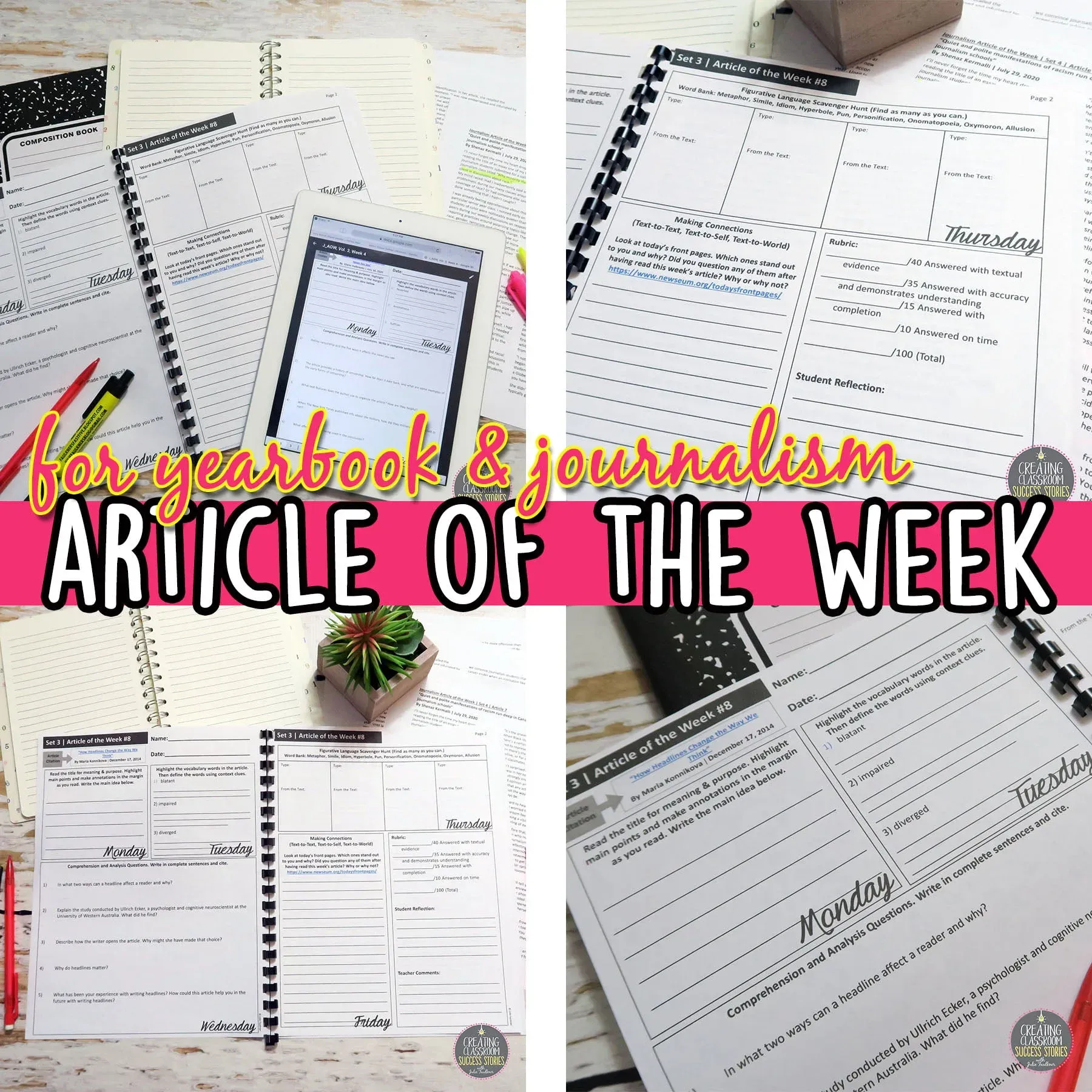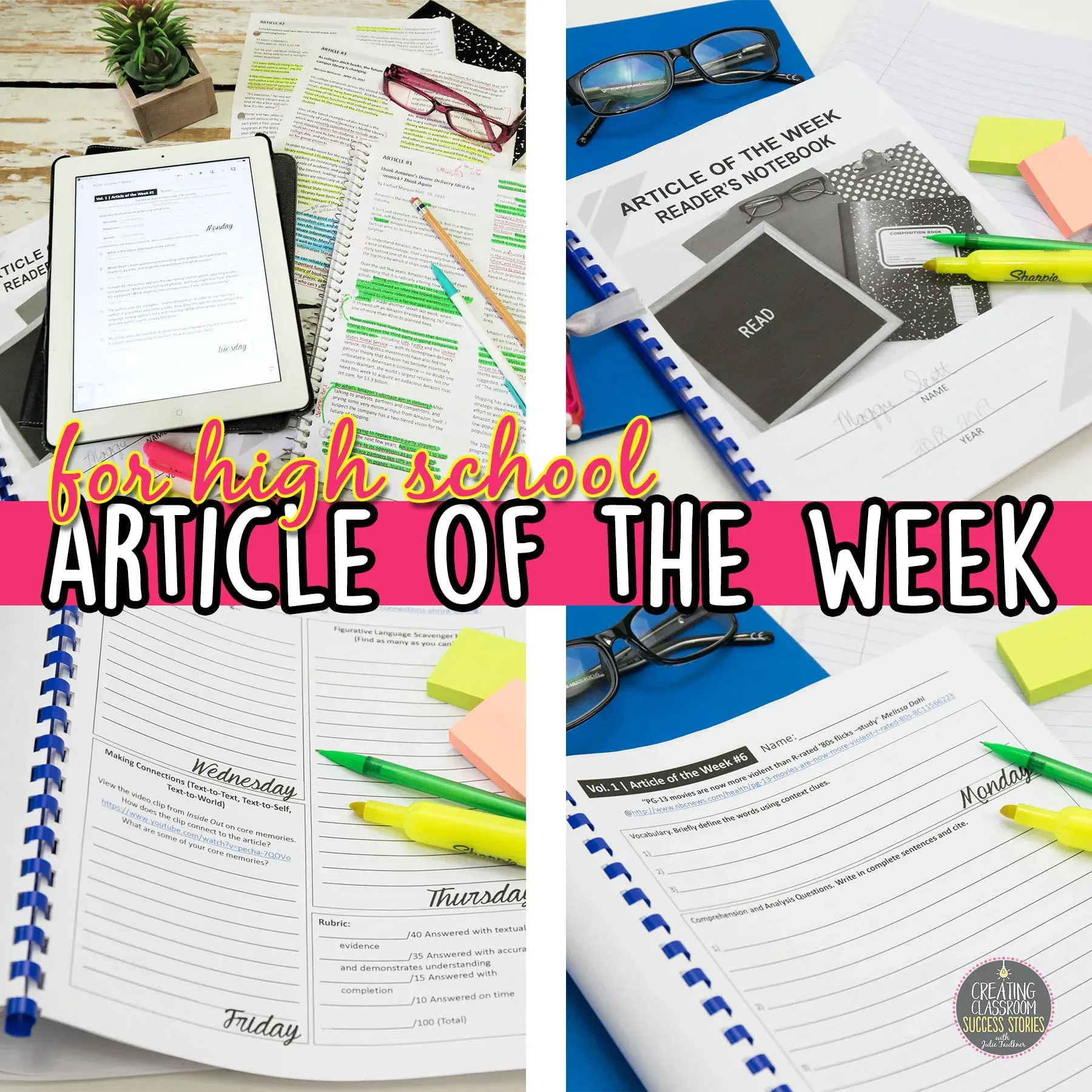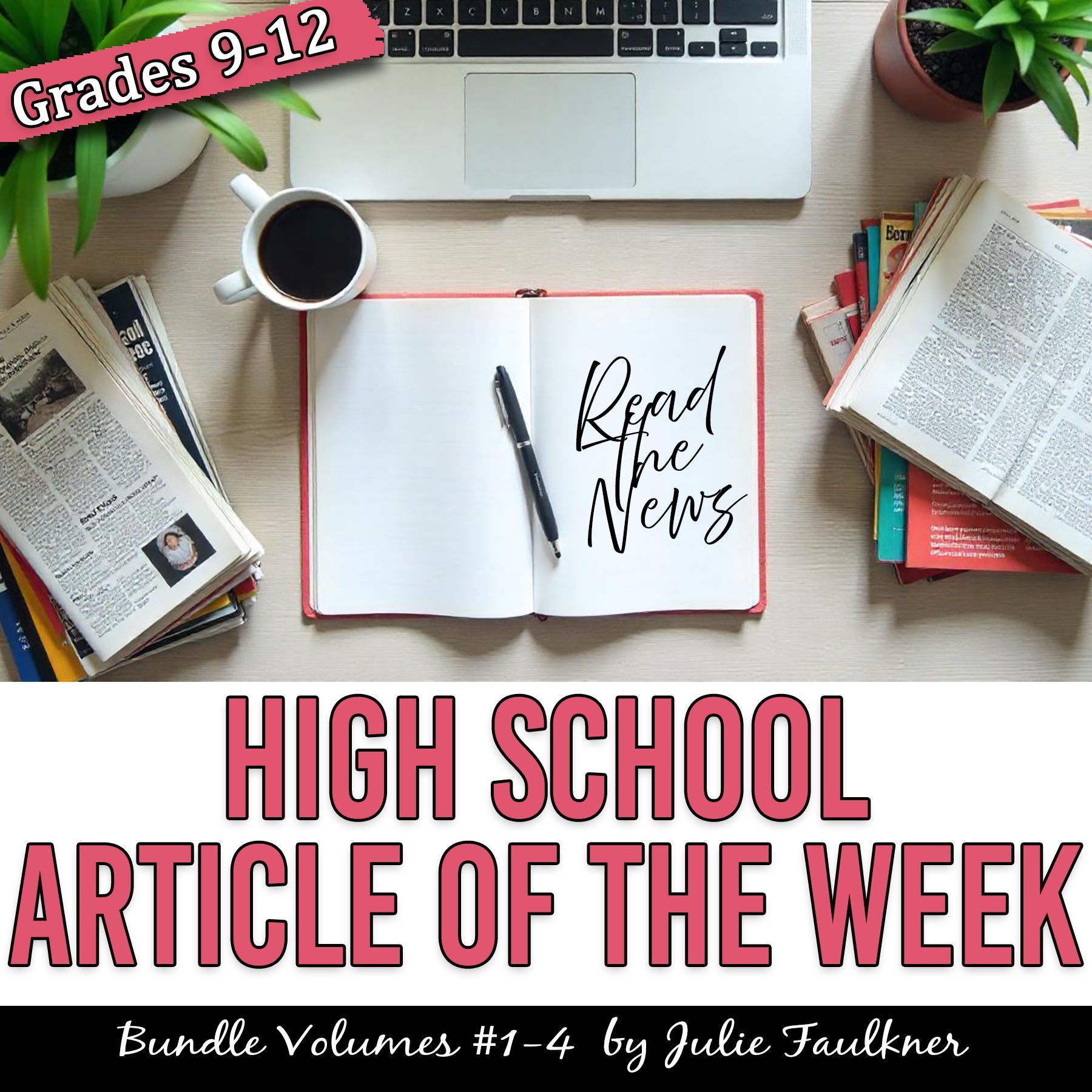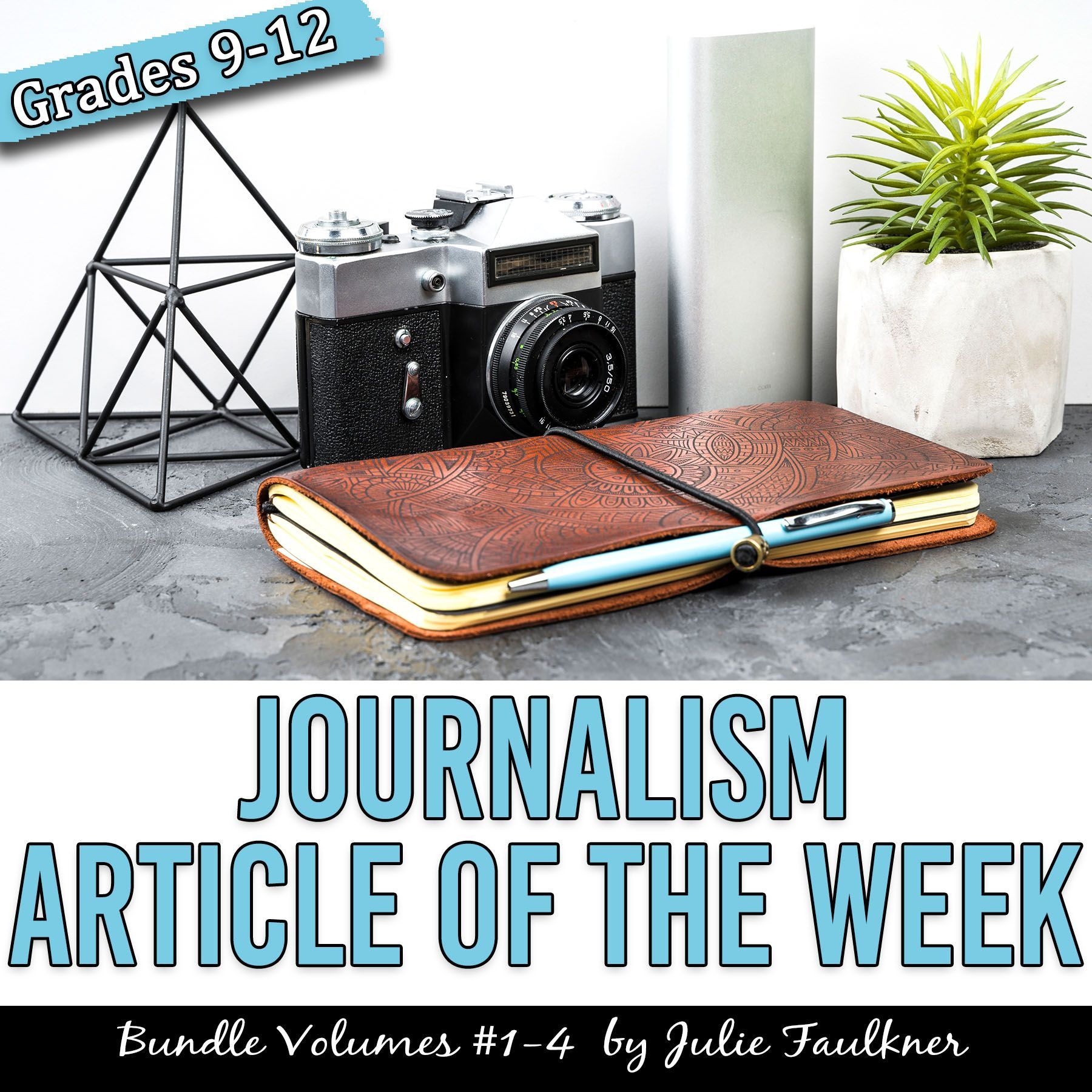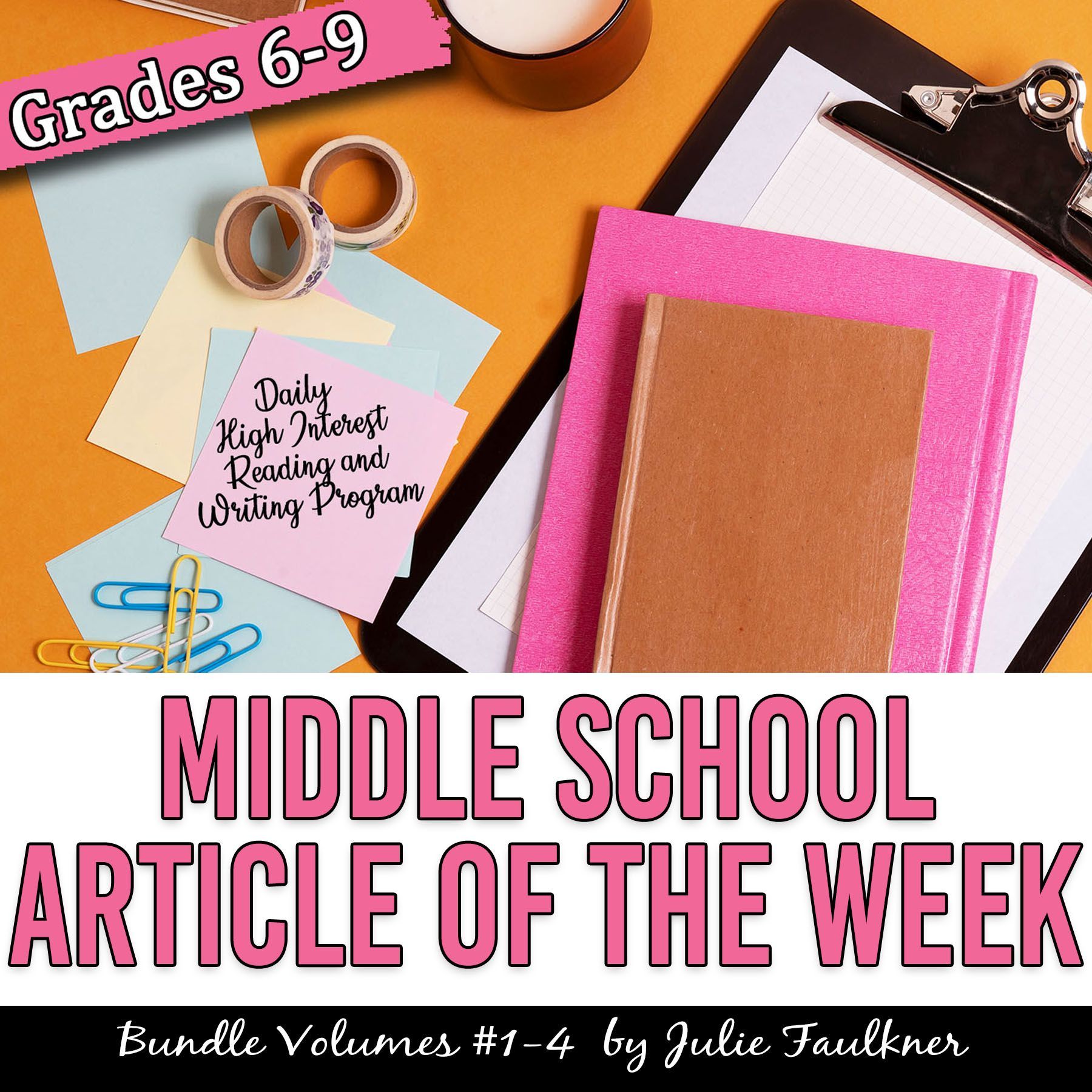Everything You Need to Know
About Article of the Week
I started using an article of the week program several years ago, and I’ve always seen amazing results. I love how flexible the system is and how much the students gain from reading and responding to a weekly article. My system — which I put my personal spin on — is planned and structured unlike others I’ve seen, but I like knowing that this method provides my students with the best possible experience. In this blog post, I’m hoping to share everything you need to know about using an article of the week in your classroom.
WHAT IS ARTICLE OF THE WEEK?
An article of the week program is a system that presents students with one article per week that they unpack daily. The article may be controversial or just informational. The article may relate to current events, or it might cover more timeless topics. Each day students will revisit the same article with a different purpose for reading and responding: one day they use context clues with vocabulary words, while another day they answer text-based questions using textual evidence and citations. Giving students a new and meaningful purpose/task each day keeps the article fresh and sparks deeper critical thinking.
WHAT ARE THE BENEFITS OF USING AN ARTICLE OF THE WEEK PROGRAM?
- Reading regularly each day improves reading comprehension. Studies show that reading as little as 5 minutes a day improves reading levels, and the more time spent reading, the higher the percentile students are likely to rank in on standardized tests. Reading speed is also greatly affected by regular reading habits.
- It strengthens writing and using textual evidence. Because I have my students use the RACE (or ACE) format when they are writing responses to their text-based questions, this system improves their writing drastically. Check out this post on using the RACE format for responding to constructed response questions. Grab my FREE sampler for teaching the RACE format. I also grade for grammar, usage, and mechanics as I am an English teacher and that fits my standards.
- It makes “real-world” connections. Students are often lost, uniformed, or partially informed when it comes to what’s going on in the world. These weekly articles, chosen carefully, help provide them with critical information.
- It is flexible for different types of classrooms and learners. I’ve used this program with inclusion classes all the way to dual enrollment college classes. I’ve used it with face-to-face classrooms and remote learning classrooms as well. Everything I’ve provided in my program (linked at the bottom) is editable and easy to modify.
- Reading builds background and content knowledge as well as vocabulary. Students who read regularly can learn 4,000 to 12,000 words per year. I believe that words live inside of texts, so rather than giving my students lists of words to memorize, I prefer having them encounter words organically and uncover their meanings in context. In my experience, students are able to retain and actually use the new words using this method.
- It prepares for standardized testing. The more exposure students have to reading grade-level material, unpacking vocabulary with context clues, and formulating written responses the better their test-taking skills become.
WHAT SHOULD YOU AVOID WHEN IMPLEMENTING ARTICLE OF THE WEEK?
- Articles that are too easy or hard for your grade level. While we need articles that have grade-level and above vocabulary and structure, we don’t want articles that students can’t even grasp. One size does not fit all.
- Articles that are too long or too short. I like to use articles that print no longer than on the front and back of a sheet.
- Articles with no relevance to students’ lives at all. You aren’t going to have 100% interest every week for every article, but if no one is ever interested, it might be that the selection of articles needs to be refreshed. Of course, we know students are going to complain, so while we do need to take most of that with a grain of salt, we do have to be open to the validity of those concerns.
- Articles with no variety of topics/content. Selecting from all modes — argumentative, expository, and narrative — will ensure that you are providing a variety of reading material. Too many political articles or too many articles warning against the dangers of social media can get old quickly.
- Not having clearly defined expectations for each article. I like giving students something new to do each day – a new task with purpose: summarizing, vocabulary, text-based responses, and real-world connections. I don’t like turning them loose 100% to figure things out. While some students are successful with that approach, most wouldn’t take it seriously enough, and that would defeat the purpose. If you like the idea of giving students “wiggle room,” a good time to do that is the first day when students first receive the article. Initially, they read highlight and annotate, and then throughout the week they can build on that work.
- Not having a clear way to measure student response. The fastest way to ruin an article of the week program is for students to realize it’s busy work. If they are being told to “just go read this article and make notes” with no truly measurable standards, is that really accomplishing the list of benefits from above?
- Articles that are too biased or always having biased articles. Teach students to read for and recognize bias, so that when you do encounter an article with author bias, they know how to process that. It’s not something to avoid entirely, but it is something that needs to be taught.
TIPS FOR HOW-TO IMPLEMENT THE PROGRAM
Step 1: Establish the format. What will students be doing each day? For my article of the week program daily layout, see below.
- Monday: Read, annotate, and summarize
- Tuesday: Vocabulary
- Wednesday: Text-specific questions
- Thursday: Figurative language scavenger hunt
- Friday: Text-to-Self or Text-to-World connections and reflection
Step 2: Decide if students will be doing the work in class or out of class. This depends on your class schedule and students’ learning levels. If you have an honors class, consider assigning it as out-of-class work, and then carve out time on Friday to share and discuss. If your students will need more guidance, dedicate the last 15-20 minutes of class to work on their article of the week daily task. It’s super flexible.
Step 3: Select articles with the criteria above and prepare text-specific questions.
Step 4: Design a rubric and/or grading expectations. A rubric can be as in depth or as simple as you would like. It is just super important to have a clear and consistent grading plan in place and let students know that up front. I do grade for content and format on the questions and accuracy on the vocabulary. Everything else is a bit subjective. Since there are only five questions per article, it helps with the grading load. It does take some time, but it is also a really good time to give feedback on writing. As an English teacher, I tend to mark grammar and style here, as well, because that helps me meet more standards.
Step 5: Model with students the first couple of weeks. How should they read and annotate? How should they use context clues? What are their written responses supposed to look like? Check out this post on using the RACE format for responding to constructed response questions. Grab my FREE sampler for teaching the RACE format.
Step 6: Carve out time at the end of the week to discuss and share. Reading and writing are only enhanced by discussion!
GET GOING WITH SOME NO-PREP SOLUTIONS
My article of the week program is a bit different than others you might have seen. Following the suggestions above, each article is selected for reading and interest level and comes with specific text-based questions. It is also provided in printable and digital for Google format. The articles are on hot topics, often current events, but also with timeless content, so you aren’t sharing “dated news” with students. The best “news”? My program is entirely no prep for you!
- High School Article of the Week Complete Set
- Yearbook/Journalism Article of the Week Complete Set
- Middle School Article of the Week
Other news outlet and websites such as Newsela, The New York Times, Time for Kids, DOGO News, The Smithsonian Tween Tribune, and News for Kids also have articles you can grab. Some, but not all, of these have questions or prompts you could assign with no prep.
I discuss my Article of the Week Program a bit more here, too, on Instagram.
You know your students best; if you are looking to give an article of the week program a try, select one that works best for everyone — you included!
Making the choice to include more reading is always a good choice!
Love this content?
Sign up for my email newsletter with more tips, ideas, success stories, and freebies!






